Abstract
Reports based on coprecipitation experiments have suggested that major histocompatibility complex class I products are complexed with the insulin receptor on the cell surface. Using an independent method that avoids the creation of immunoprecipitation artifacts during membrane solubilization, we have studied insulin receptor-class I product associations by determining the proximity between these class I products and the insulin receptor on intact cells with the use of fluorescence energy transfer. Significant energy transfer was seen between the insulin receptor and both murine H-2K- as well as H-2D-end products, indicating close proximity (e.g., within 10 nm). This cell-surface association is not from the relatively high class I density in that no significant energy transfer was measured between H-2K- vs. H-2D-end proteins. To extend these observations, we also tested whether class I products influence insulin-receptor binding and postbinding events as a result of their physical association. Using related cell lines positive and negative for class I expression, we found no correlation between insulin-receptor density or binding affinity with H-2 product expression. The class I-null variant, however, demonstrated an increase in insulin-mediated insulin-receptor internalization to suggest that if major histocompatibility complex class I products directly affect insulin-receptor function through specific cell-surface interactions, they may do so after ligand binding.
Full text
PDF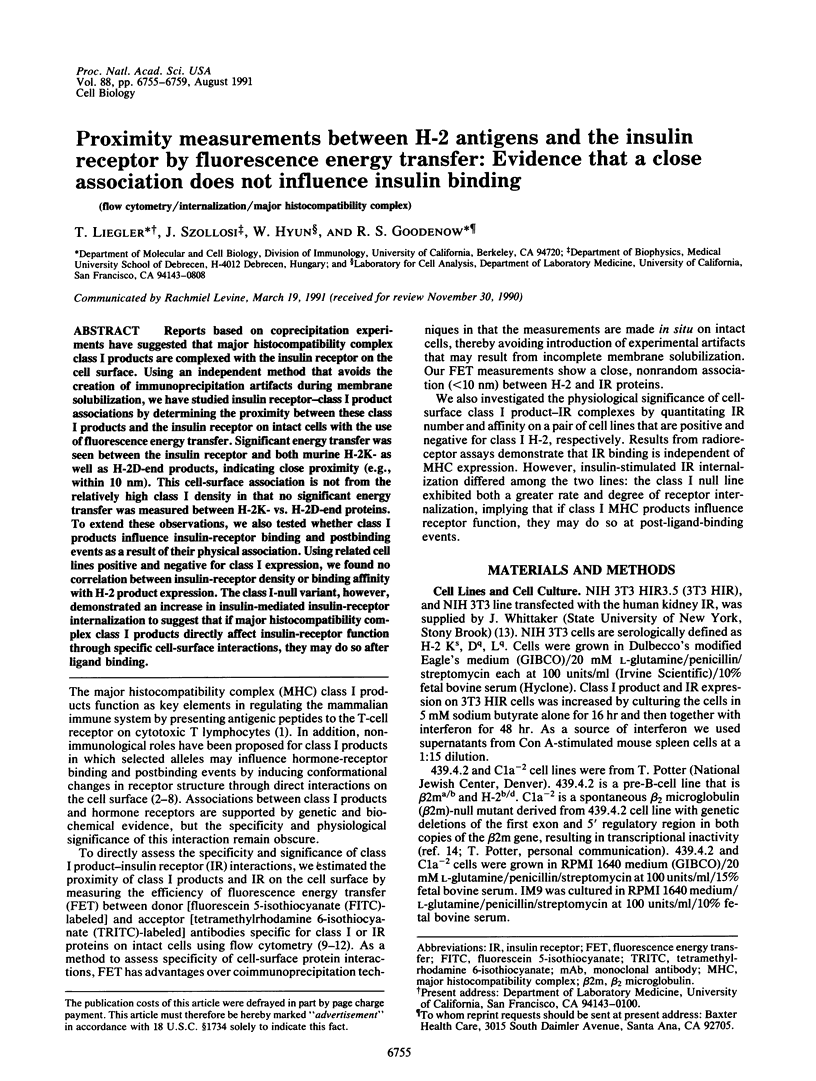
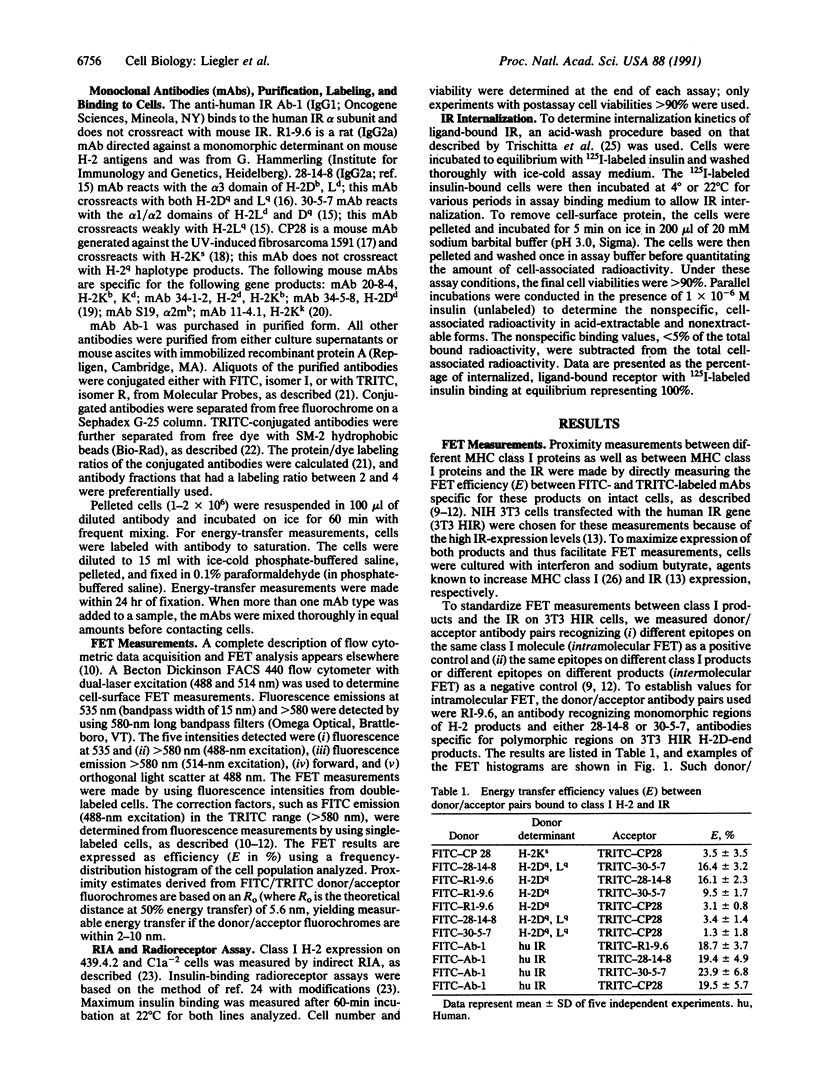
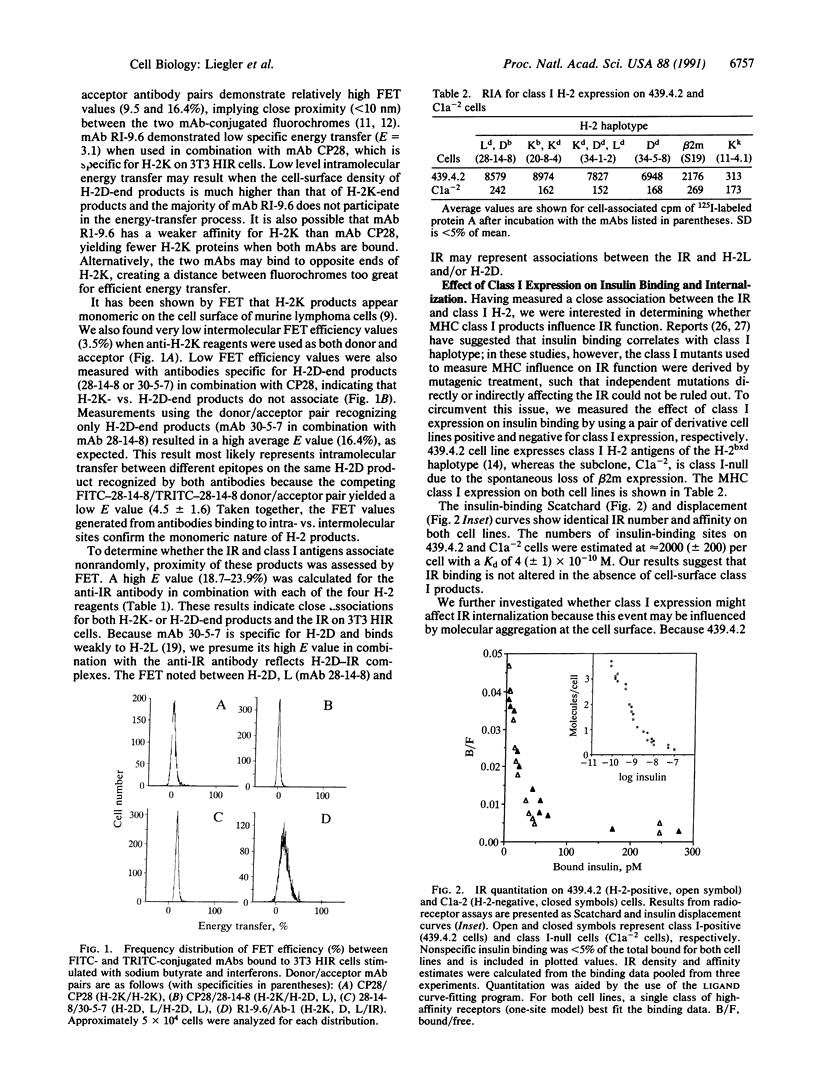
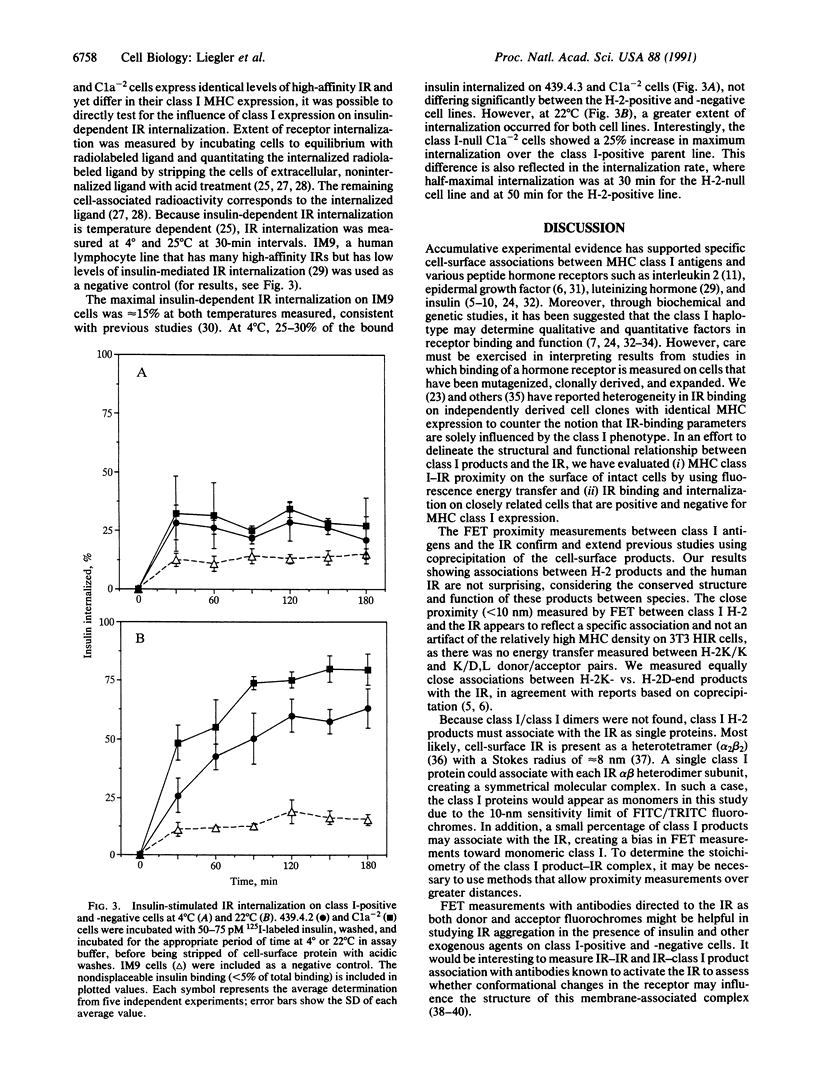
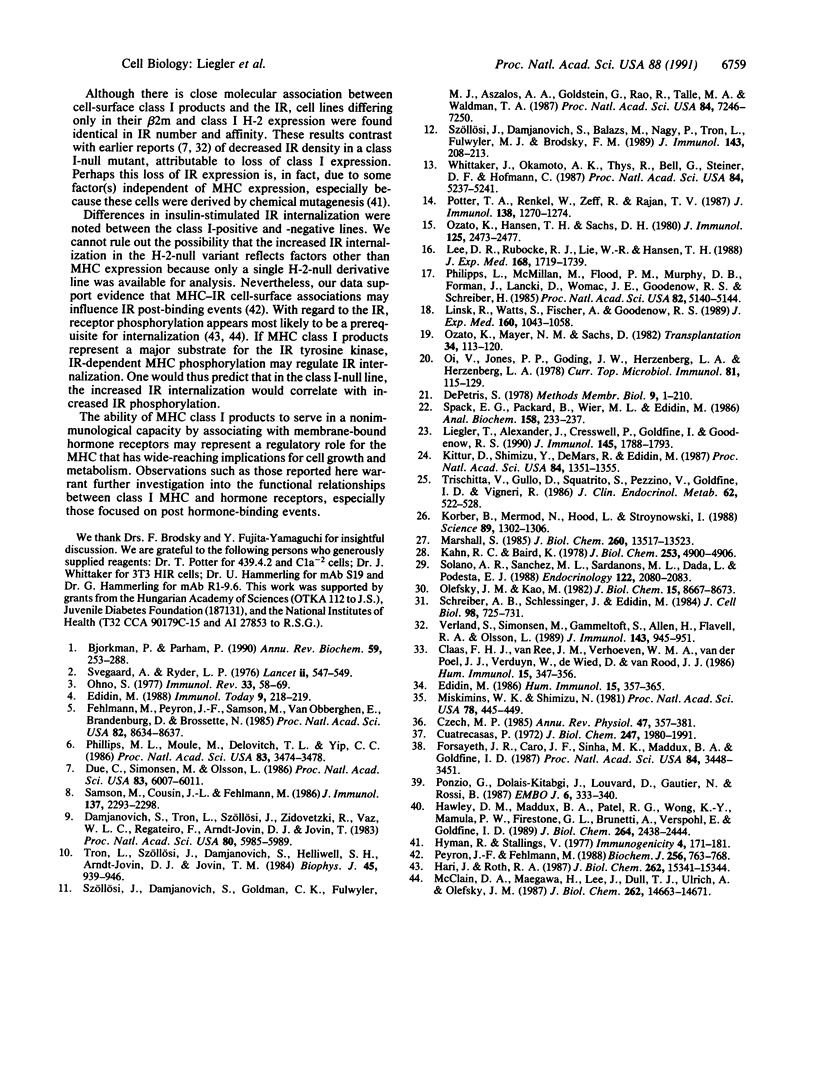
Selected References
These references are in PubMed. This may not be the complete list of references from this article.
- Bjorkman P. J., Parham P. Structure, function, and diversity of class I major histocompatibility complex molecules. Annu Rev Biochem. 1990;59:253–288. doi: 10.1146/annurev.bi.59.070190.001345. [DOI] [PubMed] [Google Scholar]
- Claas F. H., van Ree J. M., Verhoeven W. M., van der Poel J. J., Verduyn W., de Wied D., van Rood J. J. The interaction between gamma-type endorphins and HLA class I antigens. Hum Immunol. 1986 Apr;15(4):347–356. doi: 10.1016/0198-8859(86)90011-x. [DOI] [PubMed] [Google Scholar]
- Cuatrecasas P. Properties of the insulin receptor isolated from liver and fat cell membranes. J Biol Chem. 1972 Apr 10;247(7):1980–1991. [PubMed] [Google Scholar]
- Czech M. P. The nature and regulation of the insulin receptor: structure and function. Annu Rev Physiol. 1985;47:357–381. doi: 10.1146/annurev.ph.47.030185.002041. [DOI] [PubMed] [Google Scholar]
- Damjanovich S., Trón L., Szöllösi J., Zidovetzki R., Vaz W. L., Regateiro F., Arndt-Jovin D. J., Jovin T. M. Distribution and mobility of murine histocompatibility H-2Kk antigen in the cytoplasmic membrane. Proc Natl Acad Sci U S A. 1983 Oct;80(19):5985–5989. doi: 10.1073/pnas.80.19.5985. [DOI] [PMC free article] [PubMed] [Google Scholar]
- Due C., Simonsen M., Olsson L. The major histocompatibility complex class I heavy chain as a structural subunit of the human cell membrane insulin receptor: implications for the range of biological functions of histocompatibility antigens. Proc Natl Acad Sci U S A. 1986 Aug;83(16):6007–6011. doi: 10.1073/pnas.83.16.6007. [DOI] [PMC free article] [PubMed] [Google Scholar]
- Edidin M. Function by association? MHC antigens and membrane receptor complexes. Immunol Today. 1988 Jul-Aug;9(7-8):218–219. doi: 10.1016/0167-5699(88)91218-2. [DOI] [PubMed] [Google Scholar]
- Edidin M. Major histocompatibility complex haplotypes and the cell physiology of peptide hormones. Hum Immunol. 1986 Apr;15(4):357–365. doi: 10.1016/0198-8859(86)90012-1. [DOI] [PubMed] [Google Scholar]
- Fehlmann M., Peyron J. F., Samson M., Van Obberghen E., Brandenburg D., Brossette N. Molecular association between major histocompatibility complex class I antigens and insulin receptors in mouse liver membranes. Proc Natl Acad Sci U S A. 1985 Dec;82(24):8634–8637. doi: 10.1073/pnas.82.24.8634. [DOI] [PMC free article] [PubMed] [Google Scholar]
- Forsayeth J. R., Caro J. F., Sinha M. K., Maddux B. A., Goldfine I. D. Monoclonal antibodies to the human insulin receptor that activate glucose transport but not insulin receptor kinase activity. Proc Natl Acad Sci U S A. 1987 May;84(10):3448–3451. doi: 10.1073/pnas.84.10.3448. [DOI] [PMC free article] [PubMed] [Google Scholar]
- Hari J., Roth R. A. Defective internalization of insulin and its receptor in cells expressing mutated insulin receptors lacking kinase activity. J Biol Chem. 1987 Nov 15;262(32):15341–15344. [PubMed] [Google Scholar]
- Hawley D. M., Maddux B. A., Patel R. G., Wong K. Y., Mamula P. W., Firestone G. L., Brunetti A., Verspohl E., Goldfine I. D. Insulin receptor monoclonal antibodies that mimic insulin action without activating tyrosine kinase. J Biol Chem. 1989 Feb 15;264(5):2438–2444. [PubMed] [Google Scholar]
- Kahn C. R., Baird K. The fate of insulin bound to adipocytes. Evidence for compartmentalization and processing. J Biol Chem. 1978 Jul 25;253(14):4900–4906. [PubMed] [Google Scholar]
- Kittur D., Shimizu Y., DeMars R., Edidin M. Insulin binding to human B lymphoblasts is a function of HLA haplotype. Proc Natl Acad Sci U S A. 1987 Mar;84(5):1351–1355. doi: 10.1073/pnas.84.5.1351. [DOI] [PMC free article] [PubMed] [Google Scholar]
- Korber B., Mermod N., Hood L., Stroynowski I. Regulation of gene expression by interferons: control of H-2 promoter responses. Science. 1988 Mar 11;239(4845):1302–1306. doi: 10.1126/science.3125612. [DOI] [PubMed] [Google Scholar]
- Lee D. R., Rubocki R. J., Lie W. R., Hansen T. H. The murine MHC class I genes, H-2Dq and H-2Lq, are strikingly homologous to each other, H-2Ld, and two genes reported to encode tumor-specific antigens. J Exp Med. 1988 Nov 1;168(5):1719–1739. doi: 10.1084/jem.168.5.1719. [DOI] [PMC free article] [PubMed] [Google Scholar]
- Liegler T., Alexander J., Cresswell P., Goldfine I., Goodenow R. S. An analysis of insulin receptor expression and binding on MHC class I positive and negative human lymphoblastoid cells. J Immunol. 1990 Sep 15;145(6):1788–1793. [PubMed] [Google Scholar]
- Linsk R., Watts S., Fischer A., Goodenow R. S. The tumor-rejection antigens of the 1591 ultraviolet fibrosarcoma. Potential origin and evolutionary implications. J Exp Med. 1989 Mar 1;169(3):1043–1058. doi: 10.1084/jem.169.3.1043. [DOI] [PMC free article] [PubMed] [Google Scholar]
- Marshall S. Degradative processing of internalized insulin in isolated adipocytes. J Biol Chem. 1985 Nov 5;260(25):13517–13523. [PubMed] [Google Scholar]
- McClain D. A., Maegawa H., Lee J., Dull T. J., Ulrich A., Olefsky J. M. A mutant insulin receptor with defective tyrosine kinase displays no biologic activity and does not undergo endocytosis. J Biol Chem. 1987 Oct 25;262(30):14663–14671. [PubMed] [Google Scholar]
- Miskimins W. K., Shimizu N. Genetics of cell surface receptors for bioactive polypeptides: variants of Swiss/3T3 fibroblasts resistant to a cytotoxic chimeric insulin. Proc Natl Acad Sci U S A. 1981 Jan;78(1):445–449. doi: 10.1073/pnas.78.1.445. [DOI] [PMC free article] [PubMed] [Google Scholar]
- Oi V. T., Jones P. P., Goding J. W., Herzenberg L. A., Herzenberg L. A. Properties of monoclonal antibodies to mouse Ig allotypes, H-2, and Ia antigens. Curr Top Microbiol Immunol. 1978;81:115–120. doi: 10.1007/978-3-642-67448-8_18. [DOI] [PubMed] [Google Scholar]
- Olefsky J. M., Kao M. Surface binding and rates of internalization of 125I-insulin in adipocytes and IM-9 lymphocytes. J Biol Chem. 1982 Aug 10;257(15):8667–8673. [PubMed] [Google Scholar]
- Ozato K., Hansen T. H., Sachs D. H. Monoclonal antibodies to mouse MHC antigens. II. Antibodies to the H-2Ld antigen, the products of a third polymorphic locus of the mouse major histocompatibility complex. J Immunol. 1980 Dec;125(6):2473–2477. [PubMed] [Google Scholar]
- Ozato K., Mayer N. M., Sachs D. H. Monoclonal antibodies to mouse major histocompatibility complex antigens. Transplantation. 1982 Sep;34(3):113–120. doi: 10.1097/00007890-198209000-00001. [DOI] [PubMed] [Google Scholar]
- Peyron J. F., Fehlmann M. Phosphorylation of class I histocompatibility antigens in human B lymphocytes. Regulation by phorbol esters and insulin. Biochem J. 1988 Dec 15;256(3):763–768. doi: 10.1042/bj2560763. [DOI] [PMC free article] [PubMed] [Google Scholar]
- Philipps C., McMillan M., Flood P. M., Murphy D. B., Forman J., Lancki D., Womack J. E., Goodenow R. S., Schreiber H. Identification of a unique tumor-specific antigen as a novel class I major histocompatibility molecule. Proc Natl Acad Sci U S A. 1985 Aug;82(15):5140–5144. doi: 10.1073/pnas.82.15.5140. [DOI] [PMC free article] [PubMed] [Google Scholar]
- Phillips M. L., Moule M. L., Delovitch T. L., Yip C. C. Class I histocompatibility antigens and insulin receptors: evidence for interactions. Proc Natl Acad Sci U S A. 1986 May;83(10):3474–3478. doi: 10.1073/pnas.83.10.3474. [DOI] [PMC free article] [PubMed] [Google Scholar]
- Ponzio G., Dolais-Kitabgi J., Louvard D., Gautier N., Rossi B. Insulin and rabbit anti-insulin receptor antibodies stimulate additively the intrinsic receptor kinase activity. EMBO J. 1987 Feb;6(2):333–340. doi: 10.1002/j.1460-2075.1987.tb04759.x. [DOI] [PMC free article] [PubMed] [Google Scholar]
- Potter T. A., Frankel W., Zeff R. A., Rajan T. V. Spontaneous deletion at the B2m locus: evidence for site-specific genetic rearrangement. J Immunol. 1987 Feb 15;138(4):1270–1274. [PubMed] [Google Scholar]
- Samson M., Cousin J. L., Fehlmann M. Cross-linking of insulin receptors to MHC antigens in human B lymphocytes: evidence for selective molecular interactions. J Immunol. 1986 Oct 1;137(7):2293–2298. [PubMed] [Google Scholar]
- Schreiber A. B., Schlessinger J., Edidin M. Interaction between major histocompatibility complex antigens and epidermal growth factor receptors on human cells. J Cell Biol. 1984 Feb;98(2):725–731. doi: 10.1083/jcb.98.2.725. [DOI] [PMC free article] [PubMed] [Google Scholar]
- Solano A. R., Sanchez M. L., Sardanons M. L., Dada L., Podestá E. J. Luteinizing hormone triggers a molecular association between its receptor and the major histocompatibility complex class I antigen to produce cell activation. Endocrinology. 1988 May;122(5):2080–2083. doi: 10.1210/endo-122-5-2080. [DOI] [PubMed] [Google Scholar]
- Spack E. G., Jr, Packard B., Wier M. L., Edidin M. Hydrophobic adsorption chromatography to reduce nonspecific staining by rhodamine-labeled antibodies. Anal Biochem. 1986 Oct;158(1):233–237. doi: 10.1016/0003-2697(86)90614-7. [DOI] [PubMed] [Google Scholar]
- Svejgaard A., Ryder L. P. Interaction of HLA molecules with non-immunological ligands as an explanation of HLA and disease associations. Lancet. 1976 Sep 11;2(7985):547–549. doi: 10.1016/s0140-6736(76)91796-7. [DOI] [PubMed] [Google Scholar]
- Szöllösi J., Damjanovich S., Balàzs M., Nagy P., Trón L., Fulwyler M. J., Brodsky F. M. Physical association between MHC class I and class II molecules detected on the cell surface by flow cytometric energy transfer. J Immunol. 1989 Jul 1;143(1):208–213. [PubMed] [Google Scholar]
- Szöllösi J., Damjanovich S., Goldman C. K., Fulwyler M. J., Aszalos A. A., Goldstein G., Rao P., Talle M. A., Waldmann T. A. Flow cytometric resonance energy transfer measurements support the association of a 95-kDa peptide termed T27 with the 55-kDa Tac peptide. Proc Natl Acad Sci U S A. 1987 Oct;84(20):7246–7250. doi: 10.1073/pnas.84.20.7246. [DOI] [PMC free article] [PubMed] [Google Scholar]
- Trischitta V., Gullo D., Squatrito S., Pezzino V., Goldfine I. D., Vigneri R. Insulin internalization into monocytes is decreased in patients with type II diabetes mellitus. J Clin Endocrinol Metab. 1986 Mar;62(3):522–528. doi: 10.1210/jcem-62-3-522. [DOI] [PubMed] [Google Scholar]
- Trón L., Szöllósi J., Damjanovich S., Helliwell S. H., Arndt-Jovin D. J., Jovin T. M. Flow cytometric measurement of fluorescence resonance energy transfer on cell surfaces. Quantitative evaluation of the transfer efficiency on a cell-by-cell basis. Biophys J. 1984 May;45(5):939–946. doi: 10.1016/S0006-3495(84)84240-X. [DOI] [PMC free article] [PubMed] [Google Scholar]
- Verland S., Simonsen M., Gammeltoft S., Allen H., Flavell R. A., Olsson L. Specific molecular interaction between the insulin receptor and a D product of MHC class I. J Immunol. 1989 Aug 1;143(3):945–951. [PubMed] [Google Scholar]
- Whittaker J., Okamoto A. K., Thys R., Bell G. I., Steiner D. F., Hofmann C. A. High-level expression of human insulin receptor cDNA in mouse NIH 3T3 cells. Proc Natl Acad Sci U S A. 1987 Aug;84(15):5237–5241. doi: 10.1073/pnas.84.15.5237. [DOI] [PMC free article] [PubMed] [Google Scholar]


